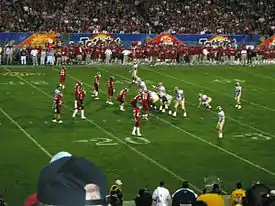| Pittsburgh Panthers football | |||
|---|---|---|---|
| |||
 | |||
| First season | 1890[1] | ||
| Athletic director | Heather Lyke | ||
| Head coach | Pat Narduzzi 8th season, 63–41 (.606) | ||
| Stadium | Acrisure Stadium (capacity: 68,400) | ||
| Year built | 2001 | ||
| Field surface | Grass | ||
| Location | Pittsburgh | ||
| NCAA division | Division I FBS | ||
| Conference | ACC (since 2013) | ||
| Division | Coastal (2013–2022) | ||
| Past conferences | Big East (1991–2012) Independent (1890–1990) | ||
| All-time record | 761–560–42 (.574) | ||
| Bowl record | 15–22–0 (.405) | ||
| Claimed national titles | 9 (1915, 1916, 1918, 1929, 1931, 1934, 1936, 1937, 1976) | ||
| Unclaimed national titles | 8 (1910, 1917, 1925, 1927, 1933, 1938, 1980, 1981) | ||
| Conference titles | 3 (2004, 2010, 2021) | ||
| Division titles | 2 (2018, 2021) | ||
| Rivalries | Cincinnati (rivalry) Notre Dame (rivalry) Penn State (rivalry) Syracuse (rivalry) West Virginia (rivalry) | ||
| Heisman winners | Tony Dorsett – 1976 | ||
| Consensus All-Americans | 55[2] | ||
| Current uniform | |||
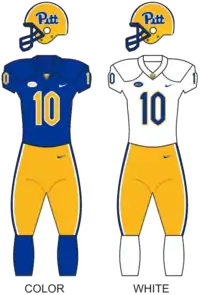 | |||
| Colors | Blue and gold[3] | ||
| Fight song | Hail to Pitt and Pitt Victory Song | ||
| Mascot | Panther | ||
| Marching band | University of Pittsburgh Varsity Marching Band | ||
| Outfitter | Nike | ||
| Website | pittsburghpanthers.com | ||
The Pittsburgh Panthers football program is the intercollegiate football team of the University of Pittsburgh, often referred to as "Pitt", in Pittsburgh, Pennsylvania. Traditionally the most popular sport at the university, Pitt football has played at the highest level of American college football competition, now termed the NCAA Division I Football Bowl Subdivision, since the beginning of the school's official sponsorship of the sport in 1890. Pitt competes as a member of the Atlantic Coast Conference (ACC).
Pitt claims nine national championships,[4] including two (1937, 1976) from major wire-service: AP Poll and Coaches' Poll, and is among the top 20 FBS college football programs in terms of all-time wins.[5] Its teams have featured many coaches and players notable throughout the history of college football, including, among all schools, the 12th most College Football Hall of Fame inductees,[6] the 8th most consensus All-Americans,[2][7] and the fourth most Pro Football Hall of Fame inductees.[8] The Panthers are coached by Pat Narduzzi. Pitt plays home games at Acrisure Stadium, formerly known as Heinz Field, which they share with the National Football League's (NFL) Pittsburgh Steelers and utilize the University of Pittsburgh Medical Center Sports Performance Complex as their practice facility.
History
National championships
Pitt-claimed

The University of Pittsburgh claims nine national championships in football. Eight of these claims (1915, 1916, 1918, 1929, 1931, 1936, 1937, and 1976)[4] are taken from the total of 11 seasons in which the Panthers have been selected as a national champion by a "major selector" as determined by the Official NCAA Records Book.[9] In addition, Pitt also claims a national championship for the 1934 season.[n 1] The university bases its claim for the five national championships from 1929 to 1937 on a 1967 article by Dan Jenkins of Sports Illustrated.[4][10] The only selector attributed for three of the five was Parke Davis.
The nine national championships claimed by Pitt are presented in its annual football media guide:[4] All selections for seasons before 1934 were made retrospectively (selected years or decades later).
| Year | Coach | Selector(s) | Record | Final AP | Final Coaches |
|---|---|---|---|---|---|
| 1915 | Pop Warner | Parke Davis | 8–0 | – | – |
| 1916 | Pop Warner | Billingsley Report, Helms Athletic Foundation, The Football Thesaurus (Houlgate System), National Championship Foundation, Parke Davis | 8–0 | – | – |
| 1918 | Pop Warner | Helms Athletic Foundation, The Football Thesaurus (Houlgate System), National Championship Foundation | 4–1 | – | – |
| 1929 | Jock Sutherland | Parke Davis | 9–1 | – | – |
| 1931 | Jock Sutherland | Parke Davis | 8–1 | – | – |
| 1934 | Jock Sutherland | Parke Davis' successor[n 2] | 8–1 | – | – |
| 1936 | Jock Sutherland | College Football Researchers Association, The Football Thesaurus (Houlgate System), Illustrated Football Annual (Boand System) | 8–1–1 | – | – |
| 1937 | Jock Sutherland | AP, Berryman QPRS, Billingsley Report, College Football Researchers Association, Dickinson System, Litkenhous, National Championship Foundation, Poling System, Sagarin Ratings, Williamson System, Illustrated Football Annual (Boand System), The Football Thesaurus (Houlgate System) | 9–0–1 | No. 1 | – |
| 1976 | Johnny Majors | AP, UPI, NFF, FWAA | 12–0 | No. 1 | No. 1 |
For seasons shown above other than the two in which Pitt was selected by a major poll as national champion, these persons created math rating systems that selected Pitt:
- Richard Billingsley 1916
- William Boand 1936
- Deke Houlgate, Sr. 1916, 1918, 1936
Other selectors shown above for seasons before major polls began:
- own selections:
- Bill Schroeder[10][15] 1916, 1918
- Parke Davis 1915, 1916, 1929, 1931, 1934 (posthumous)
- member polling:
- National Championship Foundation 1916, 1918
NCAA records book
see also: Year-by-year list of "Major" National Championship Selections
According to the Official NCAA Division 1 Football Records Book, Pitt has been named a national champion by a "Major Selector" in 11 separate seasons.[16] The seasons listed in the NCAA Records Book include:
1910 • 1915 • 1916 • 1918 • 1929 • 1931 • 1936 • 1937 • 1976 • 1980 • 1981
CFBDW
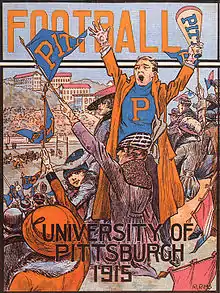
College Football Data Warehouse lists nine recognized national championship seasons in which the University of Pittsburgh was named a national champion. CFBDW lists the Joe Thompson coached 1910 undefeated and unscored upon team as a recognized national champion, whereas the university does not claim this championship. However, CFBDW does not list the 1934 season, claimed by Pitt, as a recognized championship season. The following nine seasons are the years Pitt is listed as a recognized national champion in College Football Data Warehouse:[17]
1910 • 1915 • 1916 • 1918 • 1929 • 1931 • 1936 • 1937 • 1976
According to research conducted by College Football Data Warehouse, in seven additional seasons to the ones listed above, at least one selector (some not "major") of national championships has declared Pitt as its national champion, for a total of 16 selections. In four of these seasons, there was a single selector of Pitt (1925, 1929, 1933, 1938). In 1937 and 1976 there were 27 and 31 such selectors, respectively. The 16 seasons that Pitt was selected as a national champion by at least one selector according to CFBDW research include:[14]
1910 • 1915 • 1916 • 1917 • 1918 • 1925 • 1927 • 1929 • 1931 • 1933 • 1936 • 1937 • 1938 • 1976 • 1980 • 1981
National Poll-era (1936–present)
Since the advent of the AP Poll in 1936, Pitt has been selected as its National Champion twice, in 1937 and 1976. Until the 1968 college football season, the final AP poll of the season was released following the end of the regular season, with the exception of the 1965 season, and did not consider the results of bowl games. The other major national poll, the Coaches' Poll, began in 1950 and has selected Pitt as its National Champion once, in 1976.
Summary
The following table summarizes the source and totals for Pitt's national championship seasons.
| Source | Championships | Years |
| AP / Coaches' Poll (1936–present) | Two | 1937, 1976 |
| Sports Illustrated (1967 article)[n 3] | Five | 1929, 1931, 1934, 1936, 1937 |
| CFBDW (recognized)[17] | Nine | 1910, 1915, 1916, 1918, 1929, 1931, 1936, 1937, 1976 |
| NCAA ("major" selectors)[n 4] | Eleven | 1910, 1915, 1916, 1918, 1929, 1931, 1936, 1937, 1976, 1980, 1981 |
| CFBDW (all)[14] | Sixteen | 1910, 1915, 1916, 1917, 1918, 1925, 1927, 1929, 1931, 1933, 1936, 1937, 1938, 1976, 1980, 1981 |
| Total unique seasons[n 5] | Seventeen | 1910, 1915, 1916, 1917, 1918, 1925, 1927, 1929, 1931, 1933, 1934, 1936, 1937, 1938, 1976, 1980, 1981 |
| Claimed by Pitt[n 6] | Nine | 1915, 1916, 1918, 1929, 1931, 1934, 1936, 1937, 1976 |
Conference affiliations
- Independent (1890–1990)
- Big East Conference (1991–2012)
- Atlantic Coast Conference (2013–present)
Conference championships
Pittsburgh has won three conference championships, one outright and two shared.
| Year | Coach | Conference | Overall Record | Conference Record | Bowl | Opponent | Result |
|---|---|---|---|---|---|---|---|
| 2004† | Walt Harris | Big East Conference | 8–4 | 4–2 | Fiesta Bowl | Utah | L 7–35 |
| 2010† | Dave Wannstedt | 8–5 | 5–2 | BBVA Compass Bowl | Kentucky | W 27–10 | |
| 2021 | Pat Narduzzi | Atlantic Coast Conference | 11–2 | 7–1 | Peach Bowl | Michigan State | L 21–31 |
† Co-champions
Division championships
Pittsburgh has won two division championships.
| Year | Division | Coach | Overall Record | Conference Record | Opponent | CG result |
|---|---|---|---|---|---|---|
| 2018 | ACC Coastal | Pat Narduzzi | 7–7 | 6–2 | Clemson | L 10–42 |
| 2021 | 11–2 | 7–1 | Wake Forest | W 45–21 |
Bowl games
Pitt has been to 37 bowl games throughout its history, winning 15 and losing 22.
Facilities
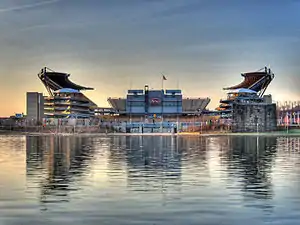
The team first played at Recreation Park. Beginning in 1900, the Panthers played their games at Exposition Park on the North Shore of Pittsburgh, sharing the stadium with the Pittsburgh Pirates.
In 1909 the Panthers, along with the Pirates, moved to Forbes Field, located on campus, where they played until 1924. In 1925, Pitt Stadium was completed on the opposite end of the campus, giving the Panthers their only private stadium. Pitt Stadium was home for the Panthers although the Steelers also used it for home games in the mid-1960s. Following the demolition of Pitt Stadium in 1999, the Panthers moved to Three Rivers Stadium, again on the North Shore, where the Pirates and Steelers had played since 1970. A handful of nationally televised Pitt Panther football games from the late 1970s to 1999 were played as home games not at Pitt Stadium but at Three Rivers with its more modern facilities.
Acrisure Stadium (formerly Heinz Field) opened in 2001, where the Panthers play as a co-tenant with the Pittsburgh Steelers. The Panthers' practice facility is the University of Pittsburgh Medical Center Sports Performance Complex which is also shared with the Steelers.
Firsts

Pitt football has been involved in several notable first-time occurrences in the history of college football, including:
- First known use of numbers on the uniforms of football players was instituted by Pitt in 1908 during the coaching tenure of John Moorehead.[18][19][20][n 7]
- First live radio broadcast of a college football game in the United States when Harold W. Arlin announced the 21–13 Pitt victory in the Backyard Brawl over West Virginia at Forbes Field in Pittsburgh on KDKA on October 8, 1921.[22]
- First nationwide television broadcast of a live sporting event, a football game against Duke at Pitt Stadium, was televised coast-to-coast by NBC on September 29, 1951.[23]
- First college football player, Tony Dorsett, at any level to rush for over 6,000 yards in a career.[24]
- First defensive player, Hugh Green, to win the Walter Camp Award (1980).[25]
- First live regular-season broadcast by ESPN of a college football game when eventual national champion BYU defeated Pitt, 20–14, at Pitt Stadium on September 1, 1984.[26]
- First sophomore, Larry Fitzgerald, to win the Walter Camp Award (2003).[27]
Traditions
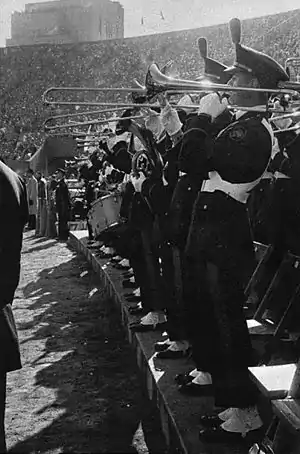
The Panther (Puma concolor) was adopted by the university as its official athletic mascot by a group of students and alumni in 1909. The suggestion to adopt the Panther as mascot was made by George M. P. Baird, Class of 1909. Over 20 representations of panthers can be found in and around the university's campus and athletic facilities, including outside Acrisure Stadium. Students, alumni, and fans rub the nose of one Panther statue in particular, the Millennium Panther located outside the William Pitt Union, in order to bring good luck to the football team prior to games.[28] This tradition was featured in a national television advertisement for the 2012 Hyundai Tucson automobile.[29] In addition, a costumed mascot, named "Roc", performs with the Pitt Cheerleaders at various athletic and non-athletic university events.
Among the oldest traditions is the Official University Yell, dating to 1890, that has survived as lyrics within the fight song "Hail to Pitt". This song, along with the Pitt Victory Song, and The Panther Song, are the most common of Pitt fight songs performed on game days by the Pitt Band. The Pitt Band also participates in the "Panthers Prowl" which begins two hours before kickoff and allows fans to meet the team as they make their way into Acrisure Stadium outside Gate A. Originally, this tradition began as players made their way into Pitt Stadium.[30][31] One hour prior to kick off, the Pitt Band also engages in the "March to Victory" from Tony Dorsett Drive down General Robinson Street and ending at the stage on Art Rooney Avenue. This tradition dates back to before the move to Acrisure Stadium when the Pitt Band would march throughout the streets of Oakland campus before arriving at Pitt Stadium.[30][31] In addition, at halftime, the band typically will play in at least one formation spelling out "PITT". Other football traditions include:
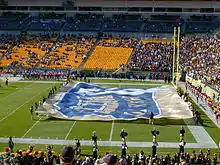
- A giant inflatable football helmet is set up on the lawn of the William Pitt Union during the week prior to football home games. Typically, information or other freebees are distributed around the helmet prior to the day of the game.[32]
- A 50-yard-long Hail to Pitt Flag is carried by 100 students, selected for each home football game, onto the field during pre-game ceremonies.[32]
- Student organizations, carrying standards, form a tunnel for the football players to run through as they enter the football field from the locker room. Originally, this long-standing tradition involved only Pitt fraternities and sororities. The tradition was briefly lost following the 1999 season when Pitt's football program transitioned from playing in Pitt Stadium to Three Rivers Stadium in 2000 followed by Acrisure Stadium in 2001. The tradition was resurrected beginning with the 2008 football season.[33]
- Following touchdowns, the horns of the Gateway Clipper riverboat fleet, which cruises just outside Acrisure Stadium, sound.
- When the Pitt offense moves into the 20-yard line, two large, motorized Heinz ketchup bottles flanking either side of the scoreboard tilt over and beginning to pour out their electronic contents onto the JumboTron's screen signifying the team's move into the "red zone".[32][34]

- The upper section of the Cathedral of Learning has been illuminated gold with "victory lights" after a football team victory since 1983.[35][36] In February 2018, a blue beam was added atop the Cathedral to accompany the gold lights.[37]
- During home games, the jumbotron leads the crowd in a "Let's Go Pitt!" version of "Sweet Caroline", originally played between the 3rd and 4th quarter, but more recently at random times during games. During away games the Pitt Band will lead the visitor Pitt fans in a rendition of the song.[38]
- Following home wins, the team gathers in front of the Pitt student section to celebrate with fans and the Pitt Band. After road wins, the team also congregates near the Pitt visiting section to celebrate.
Student section
During the late 1990s, athletic director Steve Pederson instituted a rebranding of the Pitt Stadium student section in an attempt to bolster enthusiasm and unity by emphasizing the 12th man concept. The stadium was repainted with the student section changed to section "12" and a large inflatable jersey bearing number 12 was placed near the section. Upon the move to Acrisure Stadium, the athletic department, in collaboration with their sideline apparel outfitter at the time Aéropostale, created the Aero-Zone. The Aero-Zone served as an exclusive on-field seating section for Pitt students where the first 200 students who lined up for the section before the game with student were admitted if they possessed tickets and proper identification.[39] The Aero-Zone failed to catch sustained interest and was eventually discontinued. Other groups also attempted to create a more unified student section for football.[40]
The current official Pitt football student fan club and cheering section, the Panther Pitt, was founded in 2003 by Pitt students Robin Frank and Julie Brennan to attempt to organize an Oakland Zoo-like atmosphere at Acrisure Stadium for football games. The Panther Pitt helped in coordinating student ticking policies with the athletic department and the Oakland Zoo.[41][42] In 2006, the Panther Pitt and the Pitt Student Government Board originated the concept of "Code Blue" in which students wear blue T-shirts to the game to match the home blue uniforms of the Pitt football team.[43][44] During some seasons, these shirts were commonly worn by students attending football games with the back of "Code-Blue" T-shirts typically include the line "Alle-genee-genac-genac" from the Official University Yell. In 2013, ESPN recognized the Panther Pitt as one of the nation's best college football student sections.[45]
Rivalries
For most of Pitt's football history its chief rival had been in-state foe Penn State.[46] The first Pitt-Penn State game was played in 1893. The game has been played 99 times, with Penn State holding a 52–43–4 edge in the series. After a 16-year hiatus the rivalry was renewed following Joe Paterno's death in 2012 and resumed with a 42–39 Pitt victory on September 10, 2016.[47] The 100th game of the series will take place in 2019 and is the last match up for the foreseeable future as Penn State athletic director Sandy Barbour claims that an extension will not be considered until at least 2030.[48]
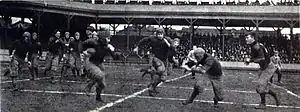
One of Pitt's fiercest rivals has been with the West Virginia Mountaineers. Dubbed the Backyard Brawl, the rivalry was first played in 1895 and is one of the oldest and most played in college football. Of historic note, the 1921 Backyard Brawl was the first live radio broadcast of a college football game in the United States. On November 10, 1979, the Backyard Brawl was the last college football game played at old Mountaineer Field in Morgantown, West Virginia, with the Panthers prevailing 24–17. Through the 2011 season, Pitt and West Virginia have met on the gridiron a total of 104 times with Pitt holding a 61–40–3 edge in the series. In September 2015 it was announced the series will renew for the 2022–2025 seasons.[49]
Other longstanding rivals include Notre Dame and Syracuse; both schools are tied as the third most played rivalry for Pitt. The series with Notre Dame began in 1909, and since that time no more than two consecutive seasons have passed without the teams meeting each other with the exception of the periods from 1913–1929, 1938–1942, and 1979–1981. Notre Dame leads the series 50–21–1. Games between Pitt and the Irish had typically been scheduled annually, however, Notre Dame's agreement to play five ACC opponents each year starting in 2014 precluded annual games, so Pitt and Notre Dame will meet no more than twice during a three-year period.[50] The rivalry with fellow ACC conference member Syracuse began in 1916, and has been played annually since 1955, with the Panthers leading the series 37–31–3. Pitt and Syracuse also shared membership in the Big East Conference from 1991 to 2012 before both schools simultaneously moved to the ACC where they are designated as cross-divisional rivals and are scheduled to meet annually.
Pitt and Navy recently renewed their rivalry, which began in 1912, and was played 26 times in 29 years between 1961 and 1989. Played consecutively between 2007 and 2009, and again in 2013, the series now stands with Pitt leading 22–14–3.[51] Of historic interest, it was during the Pitt-Navy game at Annapolis on October 23, 1976, that Pitt running back Tony Dorsett broke the NCAA career rushing record.
When the University of Cincinnati joined the Big East Conference in 2005, the game between Pitt and the Bearcats was designated as the River City Rivalry with the annual winner of the game being awarded the Paddlewheel Trophy. Each team won four games during the eight-year span that both schools shared membership in the Big East. Pitt leads the series 8–4. The series will be renewed in 2023 and 2024.[52]
Older rivalries against cross-town schools Duquesne and Carnegie Tech (now Carnegie Mellon University), as well as Washington & Jefferson, ended following the de-emphasizing of the football programs at those institutions.
Team awards and accomplishments
Undefeated seasons
.jpg.webp)
Pitt has had eight undefeated seasons. Six of the eight seasons are perfect seasons with no ties. Of the eight undefeated seasons, four are not claimed as national championship seasons by Pitt. Pitt football finished the season undefeated in:
1904 (10–0) • 1910 (9–0) • 1915 (8–0) • 1916 (8–0) • 1917 (10–0) • 1920 (6–0–2) • 1937 (9–0–1) • 1976 (12–0)
One-loss seasons
Pitt also has had 17 one-loss seasons:
1894 • 1899 • 1914 • 1918 • 1925 • 1927 • 1929 • 1931 • 1932 • 1933 • 1934 • 1935 • 1936 • 1963 • 1979 • 1980 • 1981
Eastern and Conference titles
For much of its history, Pitt played as an independent, as did the majority of what are now labeled as Division I FBS football-playing schools located in the Northeast and Mid-Atlantic. During this time, Eastern Championships were named by independent third party selectors and awarded of various trophies, such as the early Jolly Trophy awarded by the Philadelphia-based Veteran Athletic Organization which presented it to the team with the best record in the East.[53] The process of picking an Eastern Champion eventually came to be symbolized by the Lambert-Meadowlands Trophy awarded by the New Jersey Sports and Exposition Authority beginning in 1936. The Lambert-Meadowlands trophy, which is still awarded, is presented to the team deemed to be the best that located in the East or plays half its schedule against eligible Lambert teams. In total, Pitt has won 12 Eastern Championships.[54]
In addition, in 1991, the majority of football independents in the East aligned themselves together in the Big East Football Conference. Round-robin play began in the Big East beginning in 1993, although a championship was awarded during its first two years.[55]
| |||||||||||||||||||||||||||||||||||||||||||||||||||||||||||||||||||||||||||||||||||||
Number 1 ranking
Pitt has achieved the number one ranking in the major national polls (AP since 1936 and Coaches' since 1950) on the following occasions:[56]
- 1982 (September 7, October 26, November 2)
- 1981 (November 3, 10, 17, 24)
- 1976 (November 9, 16, 23, 30, January 5, 1977#)
- 1939 (October 17)
- 1938 (October 18, 25, November 1)
- 1937 (November 9, 16, 23, 30#)
#National Champion
Individual awards
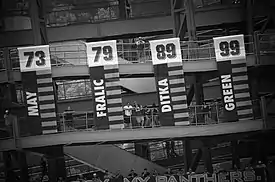
Retired numbers
Pitt has retired 10 numbers of former football players.[57]
| No. | Player | Pos. | Career |
|---|---|---|---|
| 1 | Larry Fitzgerald | WR | 2002–03 |
| 13 | Dan Marino | QB | 1979–82 |
| 33 | Tony Dorsett | RB | 1973–76 |
| 42 | Marshall Goldberg | RB | 1936–38 |
| 65 | Joe Schmidt | LB | 1950–52 |
| 73 | Mark May | OT | 1977–80 |
| 75 | Jimbo Covert | OT | 1979–83 |
| 79 | Bill Fralic | OT | 1981–84 |
| 89 | Mike Ditka | E | 1958–60 |
| 99 | Hugh Green | DE | 1977–80 |
Major award winners

|
|
|
Heisman finalists
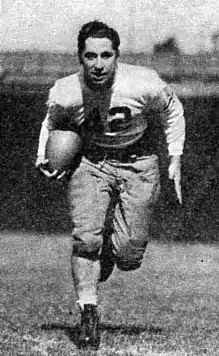
Pitt players were among the finalists for the Heisman Trophy Award in 15 different seasons.[58]
| Year | Name | Pos. | Finish |
|---|---|---|---|
| 1937 | Marshall Goldberg | RB | 3rd |
| 1938 | Marshall Goldberg | RB | 2nd |
| 1941 | Edgar Jones | RB | 7th |
| 1960 | Mike Ditka | E | 6th |
| 1975 | Tony Dorsett | RB | 4th |
| 1976 | Tony Dorsett | RB | 1st |
| 1977 | Matt Cavanaugh | QB | 7th |
| 1980 | Hugh Green | DE | 2nd |
| 1981 | Dan Marino | QB | 4th |
| 1982 | Dan Marino | QB | 9th |
| 1983 | Bill Fralic | T | 8th |
| 1984 | Bill Fralic | T | 6th |
| 1987 | Craig Heyward | RB | 5th |
| 2003 | Larry Fitzgerald | WR | 2nd |
| 2021 | Kenny Pickett | QB | 3rd |
College Football Hall of Fame inductees
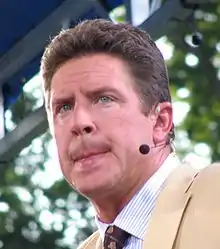
25 total former players or coaches have been inducted into the College Football Hall of Fame.
Players
The College Football Hall of Fame has inducted 19 former Panthers inducted as players.
|
|
In addition, Herb McCracken, who played at Pitt from 1918–1920, was inducted as a coach of Allegheny and Lafayette.
Coaches
The College Football Hall of Fame has inducted four former Panther coaches.
- Jock Sutherland (Pitt player from 1914–1917, and Pitt coach from 1924–1938)
- Pop Warner (Pitt coach from 1915–1923)
- Clark Shaughnessy (Pitt coach from 1943–1945)
- Len Casanova (Pitt coach in 1950)
The following two Pitt coaches have been inducted into the Hall of Fame as players at their respective schools.
- Wes Fesler (Ohio State; Pitt coach in 1946)
- Johnny Majors (Tennessee; Pitt coach from 1973–1976 and 1993–1996)

First–team All-Americans
Pitt has had 82 different players selected as First Team All-American throughout its history for a total of 98 all-time First Team All-American Selections. That total includes 55 selections which have attained Consensus status. Pitt's Consensus First Team selections ranks as the eighth most consensus All-Americans among Division I FBS schools.[2][7][59] The following list of Pitt's First Team All-Americans is compiled for the Pitt football media guide from various sources including the NCAA Football Guide, and consists of players who were first-team selections on one or more of the All American teams which were made over the years by Walter Camp, Grantland Rice, Caspar Whitney, International News Service, Associated Press, United Press International, NANA, NEA, the Football Writers Association of America, the Football Coaches Association, the All-America Board, Newsweek, The Sporting News, and Sports Illustrated.[60]
Academic All-Americans
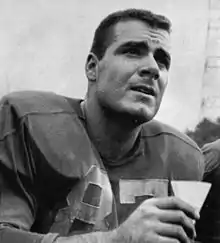
Pitt has had 15 different football players named as College Sports Information Directors of America Academic-All Americans for a total of 23 selections.[61] In addition, five Pitt players have been named as a National Scholar-Athletes by the National Football Foundation[62] and three players have awarded NCAA Postgraduate Scholarships.[59]
| Academic Honors | |||||||||||||||||||||||||||||||||||||||||||||||||||||||||||||||||||||||||||||||||||||||||
|---|---|---|---|---|---|---|---|---|---|---|---|---|---|---|---|---|---|---|---|---|---|---|---|---|---|---|---|---|---|---|---|---|---|---|---|---|---|---|---|---|---|---|---|---|---|---|---|---|---|---|---|---|---|---|---|---|---|---|---|---|---|---|---|---|---|---|---|---|---|---|---|---|---|---|---|---|---|---|---|---|---|---|---|---|---|---|---|---|---|
|
| ||||||||||||||||||||||||||||||||||||||||||||||||||||||||||||||||||||||||||||||||||||||||
| AA = Academic All-American; NCAA = NCAA Postgraduate Scholarship; NFF = National Football Foundation National Scholar-Athlete Ref:[59][61][62] *Listed as an Academic All-American in Pitt's Media Guide[62] but not by CoSIDA.[61] | |||||||||||||||||||||||||||||||||||||||||||||||||||||||||||||||||||||||||||||||||||||||||
Conference awards
The University of Pittsburgh football program was an independent for the majority of its history. It joined the Big East Conference for football in 1991, the inaugural year that the Big East sponsored the sport. Pitt won a share of the Big East football championship in 2004 and 2010. In 2013, Pitt joined the ACC. Several Panthers have won various Big East Conference football awards and Atlantic Coast Conference football awards, including Offensive Player, Defensive Player, Special Teams Player, Rookie, and Coach of the Year.
|
|
|
|
|
|
- *co-recipient, #unanimous selection
Panthers in the NFL

Pitt has produced 289 NFL players including ten that went on to be inducted into the Pro Football Hall of Fame[63] and 31 that have been selected to play in the Pro Bowl.[64] Furthermore, in a survey of NFL drafts from 1979 to 2009, ESPN rated Pitt third, behind only USC and Miami, for having "the most fertile NFL draft pipelines."[65] In addition, Pitt has been ranked second among all schools for the historical value of its drafted players.[66] Some former Pitt players that have left their mark on the NFL include Ruben Brown, Jimbo Covert, Mike Ditka, Chris Doleman, Aaron Donald, Tony Dorsett, Larry Fitzgerald, Russ Grimm, Craig "Ironhead" Heyward, Rickey Jackson, Dan Marino, Curtis Martin, Mark May, LeSean McCoy, Darrelle Revis, and Tony Siragusa.
Pro Football Hall of Fame inductees
Ten Panthers have been elected into the Pro Football Hall of Fame. Pitt is tied for fourth among all colleges and universities for the number of former players inducted.[63] Pitt's ten Hall of Famers and their year of induction and years played are:
- Joe Schmidt (Enshrined in 1973; Played 1949–1952)
- Mike Ditka (Enshrined in 1988; Played 1957–1960)
- Tony Dorsett (Enshrined in 1994; Played 1972–1976)
- Dan Marino (Enshrined in 2005; Played 1979–1982)
- Russ Grimm (Enshrined in 2010; Played 1977–1980)
- Rickey Jackson (Enshrined in 2010; Played 1977–1980)
- Curtis Martin (Enshrined in 2012; Played 1991–1994)
- Chris Doleman (Enshrined in 2012; Played 1981–1984)
- Jimbo Covert (Enshrined in 2020; Played 1978–1982)
- Darrelle Revis (Enshrined in 2023; Played 2004–2006)
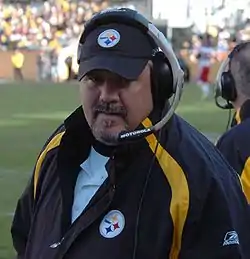
NFL All-Decade Teams
The following former Panthers were named to NFL All-Decade Teams (and 75th and 100th Anniversary All-Time Teams, selected in 1994 and 2019, respectively). Bold indicates those elected to the Pro Football Hall of Fame.
|
|
| ||||||||||||||||||||||||||||||||||||||||||||||||
|
|
|
| ||||||||||||||||||||||||||||||||||||||||||||||||||||||||||||
Pro Bowl selections
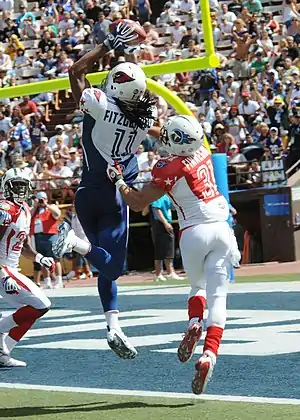
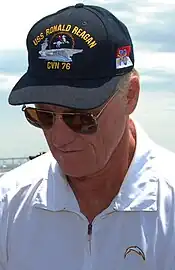
Through the 2022 NFL season, 34 former Pitt players have been selected to appear in the NFL Pro Bowl for a total of 128 all-time Pro Bowl selections. Pitt has been represented by at least one Pro Bowl selection every year since 1981.[64][67]
| Panthers selected for the Pro Bowl | |||
|---|---|---|---|
| Selection(s) | Name | Position | Team: Season(s) |
| 11 | Larry Fitzgerald | WR | Cardinals: 2005, 2007, 2008, 2009, 2010, 2011, 2012, 2013, 2015, 2016, 2017 |
| 10 | Joe Schmidt | LB | Lions: 1954, 1955, 1956, 1957, 1958, 1959, 1960, 1961, 1962, 1963 |
| 9 | Ruben Brown | G | Bills: 1996, 1997, 1998, 1999, 2000, 2001, 2002, 2003; Bears: 2006 |
| 9 | Aaron Donald | DT | Rams: 2014, 2015, 2016, 2017, 2018, 2019, 2020, 2021, 2022 |
| 9 | Dan Marino | QB | Dolphins: 1983, 1984, 1985, 1986, 1987, 1991, 1992, 1994, 1995 |
| 8 | Chris Doleman | DE | Vikings: 1987, 1988, 1989, 1990, 1992, 1993; Falcons: 1995; 49ers: 1997 |
| 7 | Darrelle Revis | CB | Jets: 2008, 2009, 2010, 2011, 2015; Buccaneers: 2013; Patriots: 2014 |
| 6 | Rickey Jackson | LB | Saints: 1983, 1984, 1985, 1986, 1992, 1993 |
| 6 | LeSean McCoy | RB | Eagles: 2011, 2013, 2014; Bills: 2015, 2016, 2017 |
| 5 | Mike Ditka | TE | Bears: 1961, 1962, 1963, 1964, 1965 |
| 5 | Curtis Martin | RB | Patriots: 1995, 1996; Jets: 1998, 2001, 2004 |
| 5 | Mark Stepnoski | C | Cowboys: 1992, 1993, 1994; Oilers: 1995, 1996 |
| 4 | Tony Dorsett | RB | Cowboys: 1978, 1981, 1982, 1983 |
| 4 | Bill Fralic | G | Falcons: 1986, 1987, 1988, 1989 |
| 4 | Russ Grimm | G | Washington: 1983, 1984, 1985, 1986 |
| 3 | Jeff Christy | C | Vikings: 1998, 1999; Buccaneers: 2000 |
| 3 | Andy Lee | P | 49ers: 2007, 2009, 2011 |
| 3 | Bill McPeak | DE | Steelers: 1952, 1953, 1956 |
| 3 | John Reger | LB | Steelers: 1959, 1960, 1961 |
| 2 | James Conner | RB | Steelers: 2018; Cardinals: 2021 |
| 2 | Jimbo Covert | T | Bears: 1985, 1986 |
| 2 | Hugh Green | LB | Buccaneers: 1982, 1983 |
| 2 | Bill Maas | NT | Chiefs: 1986, 1987 |
| 2 | Carlton Williamson | S | 49ers: 1984, 1985 |
| 1 | Fred Cox | K | Vikings: 1970 |
| 1 | Sean Gilbert | DT | Rams: 1993 |
| 1 | Marshall Goldberg | FB | Cardinals: 1941 |
| 1 | Craig Heyward | RB | Falcons: 1995 |
| 1 | Fred Hoaglin | C | Browns: 1969 |
| 1 | Mark May | T | Washington: 1988 |
| 1 | Dave Moore | TE | Buccaneers: 2006 |
| 1 | Brian O'Neill | T | Vikings: 2021 |
| 1 | John Paluck | DE | Washington: 1964 |
| 1 | Marty Schottenheimer | LB | Bills: 1965 |
NFL first round draftees
Throughout its history, the University of Pittsburgh has had 278 players selected 299 times in professional football drafts when totaling both NFL and AFL picks. This includes 27 First Round NFL draft picks since 1960.

.jpg.webp)
| Panthers selected in the first round of an NFL Draft | ||||
|---|---|---|---|---|
| Year | Name | Position | Team | overall pick |
| 1961 | Mike Ditka | TE | Bears | 5 |
| 1964 | Paul Martha | S | Steelers | 7 |
| 1977 | Tony Dorsett | RB | Cowboys | 2 |
| 1978 | Randy Holloway | DE | Vikings | 21 |
| 1981 | Hugh Green | LB | Buccaneers | 7 |
| 1981 | Randy McMillan | RB | Colts | 12 |
| 1981 | Mark May | T | Washington | 20 |
| 1983 | Jim Covert | T | Bears | 6 |
| 1983 | Tim Lewis | CB | Packers | 11 |
| 1983 | Dan Marino | QB | Dolphins | 29 |
| 1984 | Bill Maas | NT | Chiefs | 5 |
| 1985 | Bill Fralic | T | Falcons | 2 |
| 1985 | Chris Doleman | LB | Vikings | 4 |
| 1986 | Bob Buczkowski | DT | Raiders | 24 |
| 1987 | Tony Woods | LB | Seahawks | 18 |
| 1988 | Craig Heyward | RB | Saints | 24 |
| 1989 | Burt Grossman | DE | Chargers | 8 |
| 1989 | Tom Ricketts | T | Steelers | 24 |
| 1992 | Sean Gilbert | DT | Rams | 3 |
| 1995 | Ruben Brown | OL | Bills | 14 |
| 2004 | Larry Fitzgerald | WR | Cardinals | 3 |
| 2007 | Darrelle Revis | CB | Jets | 14 |
| 2008 | Jeff Otah | OL | Panthers | 19 |
| 2011 | Jon Baldwin | WR | Chiefs | 26 |
| 2014 | Aaron Donald | DT | Rams | 13 |
| 2022 | Kenny Pickett | QB | Steelers | 20 |
| 2023 | Calijah Kancey | DE | Buccaneers | 19 |
Current NFL players
As of October 16, 2023, there are 20 NFL players that played college football at the University of Pittsburgh:
|
|
Future non-conference opponents
Announced schedules as of February 11, 2023.[68]
| 2023 | 2024 | 2025 | 2026 | 2027 | 2028 | 2029 | 2030 | 2031 | 2032 | 2033 | 2034 | 2036 |
|---|---|---|---|---|---|---|---|---|---|---|---|---|
| Wofford | Kent State | Central Michigan | at Wisconsin | Wisconsin | Notre Dame | West Virginia | West Virginia | West Virginia | at West Virginia | at Notre Dame | Notre Dame | at Notre Dame |
| Cincinnati | at Cincinnati | at West Virginia | Miami (Ohio) | UConn | at UConn | Richmond | Notre Dame | |||||
| at West Virginia | West Virginia | Notre Dame | ||||||||||
| at Notre Dame | Youngstown State |
Notes
- ↑ According to Dan Jenkins in Sports Illustrated, Pitt was selected as a national champion in 1934 by Parke Davis,[10] or someone using his byline. Davis is deemed as a "major selector" of national champions only through 1933, according to the Official NCAA Records Book, and made all of his selections in 1933 just prior to his death.[11] However, a championship selection for 1934, attributed to Davis by Sports Illustrated,[10] is not included in the Official NCAA Records Book, and thus Pitt is listed in the NCAA Records Book as having been named a national champion by a "major selector" in only 11, and not 12, seasons.
- ↑ Davis died June 5, 1934. The 1934 selection is not documented in the official NCAA football records book.[12] After Davis’ death, Walter R. Okeson became the editor of the annual Spalding's Official Foot Ball Guide, which Davis had previously edited. In the Guide, Davis had compiled a list titled, "Outstanding Nationwide and Sectional Teams," for the seasons from 1869 onward. For several years, Okeson continued to add annual selections to this list, described as "Originally Compiled by the late Parke H. Davis."[13]: 233–35 The 1935 Guide stated, in Okeson's review of the 1934 season, "Minnesota — Undefeated and untied, team was generally conceded to be national leader," and "Pittsburgh — Defeated only by Minnesota, team was generally rated as strongest in East."[13]: 173–74 Okeson listed both schools as "Outstanding Nationwide Teams" for 1934.[13]: 235 All 13 major selectors and 26 others chose Minnesota and Alabama.[14]
- ↑ Based on a September 11, 1967 Sports Illustrated article.[4][10]
- ↑ National Championships as listed in the Official NCAA Football Records Book as selected by "Major Selectors". The NCAA itself does not recognize or discriminate between national championship selections.[11]
- ↑ The total of 17 national championship season selections is arrived at by combining the 16 seasons listed by College Football Data Warehouse[14] plus the 1934 selection listed by Sports Illustrated as being by Parke Davis.[4][10]
- ↑ The University of Pittsburgh officially claims 9 national championships for the Panthers football team. The University of Pittsburgh bases its claim for the five 1929–1937 national championships on a 1967 Sports Illustrated article. The only selector attributed for three of the five was Parke Davis. These championships, together with its consensus championship of 1976, are the basis for six of the university's claim of 9 national championship seasons.[4][10]
- ↑ The Official NCAA Records Book credits Washington & Jefferson as being the first documented college football team to use uniform numbers in 1908,[21] although photographic evidence indicates that numbers were worn by the 1907 WUP football team.
References
- ↑ Borghetti, E.J.; Feeley, Ted; Welsh, Celeste; et al., eds. (July 19, 2014). 2014 Pitt Football Media Guide (PDF). University of Pittsburgh Athletic Media Relations Office. pp. 118–119. Archived from the original (PDF) on November 17, 2015. Retrieved May 17, 2015.
- 1 2 3 Carter, Christopher (December 12, 2022). "Calijah Kancey becomes Pitt's 55th consensus first team All-American". Pittsburgh Post-Gazette. Retrieved February 9, 2023.
- ↑ "Color Palette". Pitt Athletics Brand Identity Manual (PDF). February 9, 2022. Retrieved July 10, 2022.
- 1 2 3 4 5 6 7 Borghetti, E.J.; Nestor, Mendy; Welsh, Celeste, eds. (2008). 2008 Pitt Football Media Guide (PDF). University of Pittsburgh. p. 156. Archived from the original (PDF) on May 23, 2011. Retrieved July 7, 2010.
To settle countless arguments, Sports Illustrated in 1970 [sic] researched the first and only complete and wholly accurate list ever compiled of college football's mythical national champions [sic]. Every recognized authority that ever presumed to name a No. 1 was included [sic].
- ↑ "Football Bowl Subdivision Records". 2018 NCAA Official Records Book (PDF). Indianapolis: National Collegiate Athletic Association. 2018. p. 101. Retrieved July 3, 2019.
- ↑ "National Football Foundation Hall of Fame". 2019. Retrieved July 3, 2019.
- 1 2 "Football Award Winners". 2018 NCAA Football Records Book (PDF). Indianapolis: National Collegiate Athletic Association. 2012. p. 18. Retrieved May 9, 2014.
- ↑ "Hall of Famers by College". Pro Football Hall of Fame. Retrieved July 3, 2019.
- ↑ "2008 NCAA Division I Records Book, pgs. 76–81" (PDF). Retrieved January 8, 2009.
- 1 2 3 4 5 6 7 Jenkins, Dan (September 11, 1967). "This Year The Fight Will Be In The Open". Sports Illustrated. Vol. 27, no. 11. Chicago: Time Inc. pp. 30–33. Retrieved February 8, 2016.
On this and the following pages is a complete list of college football's mythical champions as selected by every recognized authority since 1924 [sic]. The selectors represented are the Parke H. Davis Selections (1924-1935) [sic], the Dickinson System (1924-1940), The Football Annual (1924-1941), The Football Thesaurus (1927-1958), the Helms Athletic Foundation (1924-1966), the Dunkel System (1929-1966), the Litkenhous System (1934-1966), the Williamson System (1932-1963), Associated Press (1936-1966), United Press International (1950-1966), the Football Writers' Association (1954-1966) and the National Football Hall of Fame (1959-1966).
- 1 2 Official 2009 NCAA Division I Football Records Book (PDF). Indianapolis: The National Collegiate Athletic Association. August 2009. pp. 76–77. Retrieved October 16, 2009.
- ↑ 2012 NCAA Football Records (PDF). The National Collegiate Athletic Association. 2012. pp. 69–73. Retrieved March 8, 2013.
- 1 2 3 Okeson, Walter R., ed. (1935). Spalding's Official Foot Ball Guide 1935. New York: American Sports Publishing Co.
- 1 2 3 4 "College Football Data Warehouse: Pittsburgh All National Championships: Pittsburgh Total National Championships". CFBDataWarehouse.com. Archived from the original on July 4, 2008. Retrieved April 8, 2009.
- ↑ Scott, Jon (November 9, 2010). "The truth behind the Helms Committee". Retrieved December 14, 2015.
- ↑ 2012 NCAA Football Bowl Subdivision Records (PDF). Indianapolis: The National Collegiate Athletic Association. August 2012. pp. 71–73. Retrieved December 28, 2012.
- 1 2 "Pittsburgh Recognized National Championships". College Football Data Warehouse. Archived from the original on September 7, 2015. Retrieved August 11, 2016.
- ↑ O'Brien, Jim, ed. (1982). Hail to Pitt: A Sports History of the University of Pittsburgh. Wolfson Publishing Co. p. 62. ISBN 0-916114-08-2.
- ↑ Sullivan, George (2004). Any Number Can Play: The Numbers Athletes Wear. Millbrook Press. p. 13. ISBN 0-7613-1557-8.
- ↑ Murphy, Arthur (September 28, 1959). "Memo From The Publisher". Sports Illustrated. p. 15. Archived from the original on December 6, 2012.
- ↑ "College Football Rules Changes – Equipment" (PDF). Football Bowl Subdivision Records. National Collegiate Athletic Association. 2009. p. 130. Archived from the original (PDF) on February 15, 2010. Retrieved June 2, 2010.
- ↑ Sciullo, Sam Jr., ed. (1991). 1991 Pitt Football: University of Pittsburgh Football Media Guide. University of Pittsburgh Sports Information Office. p. 116.
- ↑ Pedersen, Paul M.; Parks, Janet B.; Quarterman, Jerome; Thibault, Lucie, eds. (2011). Contemporary Sport Management (4th ed.). Champaign, Illinois: Human Kinetics. p. 50. ISBN 978-0-7360-8167-2. Retrieved March 25, 2012.
- ↑ "Official 2008 NCAA Division I Football Records Book" (PDF). Official ... NCAA Division 1 Football Records Book. Indianapolis: The National Collegiate Athletic Association: 195–196. August 2008. ISSN 0735-5475. Retrieved August 19, 2009.
- ↑ Hugh Green at the College Football Hall of Fame
- ↑ Humes, Michael (August 20, 2013). ""By the Numbers": Three-Part Look at College Football on ESPN Networks – Part 1" (Press release). ESPN MediaZone. Retrieved August 26, 2013.
- ↑ Zeise, Paul (December 12, 2003). "Double Win For Fitzgerald". Pittsburgh Post-Gazette. Retrieved November 29, 2011.
- ↑ "Alumni Traditions: Rub the Panther's Nose". Pitt Alumni Association. June 23, 2010. Retrieved November 29, 2011.
- ↑ 2012 Hyundai Tucson: "Nose Rub" (Television commercial). HyundaiUSA. September 30, 2011. Archived from the original on July 23, 2013. Retrieved April 28, 2012.
- 1 2 "2008 Panther Football Fan Guide, pg. 2, ISP Sports;" (PDF). Archived from the original (PDF) on May 23, 2011. Retrieved August 24, 2008.
- 1 2 "Pitt Traditions Part of Debut Season at New Heinz Field; Pitt Campaign Chronicle; August 20/27, 2001". Retrieved August 24, 2008.
- 1 2 3 "Pitt Traditions". Pitt Alumni Association. June 23, 2010. Retrieved November 29, 2011.
- ↑ "PittsburghPanthers.com - University of Pittsburgh Official Athletic Site - Football". Archived from the original on July 18, 2012.
- ↑ "Giant Heinz Ketchup Bottles Make Their NFL Debut During Steelers-Titans Game; Monday Night Football Shines at Heinz Field". Business Wire. October 29, 2001. Retrieved November 29, 2011.
- ↑ Bennett, Brian (2010). "Big East game-day traditions: Pittsburgh". ESPN. Retrieved March 4, 2010.
- ↑ Rieker, Richard, ed. (November 1983). "Panther turn-on". Pitt. University of Pittsburgh Department of News and Communications. 38 (2): 1. Retrieved November 6, 2016.
- ↑ "New Pitt Victory Lights Unveiled". Pitt Panthers #H2P. February 7, 2018. Retrieved June 26, 2019.
- ↑ Gibb, Emily (November 26, 2010). "'Sweet Caroline' boosts Brawl". Pittsburgh Post-Gazette. Retrieved November 26, 2010.
- ↑ Masny, Daniel (August 29, 2001). "Coach Harris calls on the 12th man". The Pitt News. Retrieved April 20, 2008.
- ↑ "Cat Basket". thecatbasket.blogspot.com.
- ↑ "Student Organization Resource Center: Panther Pitt". University of Pittsburgh Office of Student Life. March 6, 2008. Retrieved April 19, 2008.
- ↑ Schwab, Nikki (October 24, 2003). "Panther Pitt colors games blue and gold with towels". The Pitt News. Retrieved November 29, 2011.
- ↑ "Thomas, Dave; Panthers face must-win game against Mountaineers; Pitt News, November 15, 2006". Retrieved August 25, 2008.
- ↑ "EDITORIAL – Priestas best choice for SGB president, The Pitt News, November 7, 2007". Retrieved August 25, 2008.
- ↑ "Best Student Sections in College Football: Pittsburgh". ESPN.com. August 15, 2013. Retrieved August 13, 2013.
- ↑ Paths of Glory: The Dramatic Story of Pitt's First Century of Football (video). Wetterau Corporation and Ross Sports Productions. 1990. Retrieved April 29, 2017.
- ↑ Fittipaldo, Ray (June 14, 2011). "Pitt, Penn State to renew football rivalry in 2016". Pittsburgh Post-Gazette. Retrieved June 14, 2011.
- ↑ Drey, Abby. "Penn State-Pitt rivalry renewal put on hold due to 'complicating puzzle'". centredaily. Retrieved June 26, 2019.
- ↑ "Pitt, West Virginia Renew Backyard Brawl for 2022-2025". September 10, 2015.
- ↑ Keller, Mathew (May 28, 2005). "Notre Dame, Big East agree to series of football games". Pittsburgh Tribune-Review. Archived from the original on June 9, 2008. Retrieved January 13, 2010.
- ↑ "Pitt Future Non-Conference Football Schedules". PittsburghPanthers.com. Archived from the original on December 31, 2009. Retrieved January 13, 2010.
- ↑ "Pitt, Cincinnati schedule 2023-24 footballs series". June 17, 2015.
- ↑ "The Owl | Documenting Pitt". documenting.pitt.edu.
- 1 2 University of Pittsburgh 1975 football media guide. University of Pittsburgh. 1975. p. 54. Retrieved August 26, 2008.
- ↑ Sullivan, Chuck, ed. (2008). Big East Conference 2008 Football Media Guide (PDF). Providence, Rhode Island: Big East Conference. p. 133. Archived from the original (PDF) on February 4, 2009. Retrieved March 17, 2009.
- ↑ Sullivan, Chuck, ed. (2008). Big East Conference 2008 Football Media Guide (PDF). Providence, Rhode Island: Big East Conference. p. 188. Archived from the original (PDF) on February 4, 2009. Retrieved March 17, 2009.
- ↑ "Larry Fitzgerald Joins Legendary List of Pitt Retired Jerseys". PittsburghPanthers.com. July 1, 2013. Archived from the original on July 7, 2014. Retrieved July 1, 2013.
- ↑ "Heisman Trophy: Heisman Winners". Heisman.com. Archived from the original on August 1, 2014. Retrieved February 6, 2012.
- 1 2 3 Sullivan, Chuck, ed. (2008). Big East Conference 2008 Football Media Guide (PDF). Providence, Rhode Island: Big East Conference. p. 168. Archived from the original (PDF) on February 4, 2009. Retrieved March 17, 2009.
- 1 2 Borghetti, E.J.; Nestor, Mendy; Welsh, Celeste, eds. (2008). 2008 Pitt Football Media Guide (PDF). University of Pittsburgh. p. 158. Archived from the original (PDF) on May 23, 2011.
- 1 2 3 CoSIDA Academic All-American All-Time List (by School) (PDF), College Sports Information Directors of America, March 8, 2012, pp. 352–353, retrieved June 2, 2012
- 1 2 3 4 Borghetti, E.J.; Nestor, Mendy; Welsh, Celeste, eds. (2008). 2008 Pitt Football Media Guide (PDF). University of Pittsburgh. p. 164. Archived from the original (PDF) on May 23, 2011.
- 1 2 "Hall of Famers by College". Pro Football Hall of Fame. Retrieved February 4, 2012.
- 1 2 "Pittsburgh Players/Alumni". Pro-Football-Reference.com. Retrieved August 9, 2010.
- ↑ Schlabach, Mark (May 10, 2010). "SEC not alone in elite NFL talent". ESPN.com. Retrieved May 12, 2010.
- ↑ Tuccitto, Danny (April 16, 2013). "Historical Draft Efficiency: College Rankings". Football Outsiders. Retrieved May 30, 2013.
- ↑ Nestor, Mendy; Borghetti, E.J.; Welsh, Celeste, eds. (2010). 2010 Pitt Football Media Guide (PDF). University of Pittsburgh. p. 194. Archived from the original (PDF) on November 12, 2012. Retrieved August 8, 2010.
- ↑ "Pitt Panthers Football Schedules and Future Schedules". fbschedules.com. Retrieved February 11, 2023.
Further information
- University of Pittsburgh Football Vault: The History of the Panthers. Sam Sciullo, Jr. Atlanta: Whitman Pulblishing, 2008, ISBN 0-7948-2653-9
- University of Pittsburgh Football Media Guide 2008. E.J. Borghetti, Mendy Nestor, and Celeste Welsch eds. Pittsburgh: University of Pittsburgh, 2008
- Paths of Glory: The Dramatic Story of Pitt's First Century of Football. Video. Ross Sports Productions. 1991
- Greatest Moments in Pitt Football History. Mike Bynum, Larry Eldridge, Jr., and Sam Sciullo, Jr. eds. Nashville, Tennessee: Athlon Sports Communications, 1994, ISBN 1-878839-04-7
- Hail to Pitt: A Sports History of the University of Pittsburgh. Jim O'Brien, ed. and Marty Wolfson, illus. Pittsburgh; Wolfson Publishing Co., 1982, ISBN 978-0916114084
- Pitt: The Story of the University of Pittsburgh 1787–1987. Robert C. Alberts. Pittsburgh, Pennsylvania: University of Pittsburgh Press, 1986, ISBN 0-8229-1150-7
- Sciullo, Sam Jr. (2000). Pitt Stadium Memories 1925–1999. University of Pittsburgh. ASIN B0006RFHJQ.
- Tales from the Pitt Panthers. Sam Sciullo, Jr. Champaign, Illinois: Sports Publishing LLC, 2004, ISBN 1-58261-198-X
- The Year the Panthers Roared. Francis J. Fitzgerald, ed., Louisville, Kentucky, AdCraft Sports, 1996, ISBN 1-887761-06-3
- Jock Sutherland: Architect of Men. Harry G. Scott. New York: Exposition Press, 1954.
